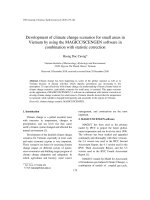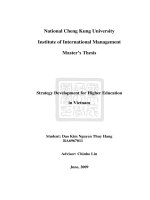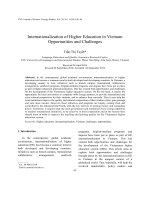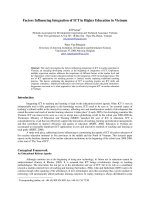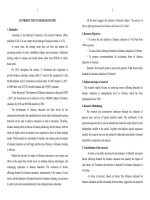strategy development for higher education in vietnam
Bạn đang xem bản rút gọn của tài liệu. Xem và tải ngay bản đầy đủ của tài liệu tại đây (2.5 MB, 88 trang )
National Cheng Kung University
Institute of International Management
Master’s Thesis
Strategy Development for Higher Education
in Vietnam
Student: Dao Kim Nguyen Thuy Hang
RA6967011
Advisor: Chinho Lin
June, 2009
I
ACKNOWLEDGEMENTS
First of all, I would like to express my sincere thanks and appreciation to
Professor Chinho Lin, my advisor for giving me valuable directions. My thesis would
not have been completed without his guidance. It is impossible to forget his efforts on
a lot of methodological comments and analytical guidance.
I would also like to express my gratitude to my professor, committee members,
Dr. Jeng-Chung (Victor) Chen, Dr. Don Jyh-Fu Cheng, Dr. Pei-Hsuan Hsieh for their
positive, constructive and useful comments, acceptance, and support.
Huge thanks must go to Professor Dr. Richard Lynch at Middlesex University
London and Professor Dr. Paul Baines at Cranfield University in UK for their help
and spend countless hours discussing ideas and advising me on various aspects.
My sincere thanks and appreciation go to Professor and President Dr. Phan
Thanh Binh, Associate Professor and Vice President Dr. Huynh Thanh Dat of
Vietnam National University-Ho Chi Minh City (VNU-HCM) and all of the
professors, directors, vice directors, managers, experts, and staffs in VNU-HCM and
many universities in Vietnam for their unique and amazing friendship and support,
whose contributions of time and talent to my study.
I would also like to express my gratitude to all of the professors in the IMBA
program, IMBA staffs as well.
I owe a debt of thanks to all those mentioned here, as well as to the many other
friends who have encouraged me on this venture. I couldn‘t have done it without you.
I hope you think it worthwhile.
II
Finally, thanks to my family for bringing me up and supporting me all along.
Special, I would like to extend my heartfelt gratitude to my mother who supports a
living for me nearly 30 years.
III
ABSTRACT
Keywords: Resource based view (RBV), Funding, Higher education performance,
Strategy.
This study intends to determine the relationship among RBV (reputation,
architecture, innovation capability, core competencies, and knowledge based
advantages) and funding and higher education performance. The moderating effects
of psychological contract fulfillment and reward orientation on the relationship
between funding and higher education performance were also examined.
In order to avoid the bias, the way to distribute the questionnaire survey was
mostly to contact directly, via phone or email to distribute all questionnaire sheets to
all members, managers, experts, directors, vice directors, presidents and vice
presidents. And based on the results of this empirical study, the findings show that
there is a strong relationship among RBV (reputation, architecture, innovation
capability, core competencies and knowledge based advantages) and funding and
higher education performance. Thus, we employ the RBV of strategy development to
explore the strength and the weakness of higher education in Vietnam. The paper also
explores whether or not universities in Vietnam can apply, improve or learn more the
RBV concepts. Then, the next step is to examine how funding and higher education
performance are related to the university‘s mission and objectives, so as to influence
the government policy.
IV
TABLE OF CONTENTS
ACKNOWLEDGEMENTS I
ABSTRACT III
TABLE OF CONTENTS IV
LIST OF TABLES VII
LIST OF FIGURES IX
CHAPTER ONE INTRODUCTION 1
1.1 Research Background and Motivation. 1
1.2 Research Objectives. 5
1.3 Research Flow and The Structure of This Study. 6
1.3.1 Research Flow. 6
1.3.2 The Structure of This Study. 7
CHAPTER TWO LITERATURE REVIEW 9
2.1 Definition of Constructs. 9
2.1.1 Resource Based View. 9
2.1.2 Funding. 17
2.1.3 Higher Education Performance (HE Performance). 20
2.2 Relationships between Constructs. 22
2.2.1 RBV and Funding. 22
2.2.2 RBV and Higher Education Performance. 24
2.2.3 Funding and HE Performance. 25
CHAPTER THREE RESEARCH DESIGN AND METHODOLOGY 29
V
3.1 The Conceptual Model. 30
3.2 Questionnaire Design Procedures. 30
3.3 Hypotheses to be Tested. 33
3.4 Sampling Plan. 34
3.5 Data Analysis Procedures. 35
3.5.1 Descriptive Statistic Analysis. 36
3.5.2 Factor Analysis and Reliability Test. 36
3.5.3 T-test and One Way Anova (F-test). 37
3.5.4 Multiple Regression Analysis. 38
CHAPTER FOUR DATA ANALYSIS AND MEASUREMENTS 39
4.1 Sample and Data Collection Procedures. 39
4.2 Characteristics of Respondents. 40
4.3 Descriptive Statistics. 42
4.4 Factor Analysis and Reliability. 46
4.5 Independent Sample T-test and One Way ANOVA (F-test). 49
4.5.1 Independent Sample T -test. 49
4.5.2 One Way ANOVA (F-test). 50
4.6 Relationships Among Constructs – Multiple Regression Analysis. 53
4.6.1 The Influences of RBV (Reputation, Innovation Capability,
Architecture, Core Competencies, and Knowledge Based Advantages)
on Funding. 53
4.6.2 The Influences of RBV (Reputation, Innovation Capability,
Architecture, Core Competencies, and Knowledge Based Advantages)
on Higher Education Performance. 54
4.6.3 The Influences of Funding on Higher Education Performance. 56
VI
CHAPTER FIVE CONCLUSION AND SUGGESTIONS 57
5.1 Research Findings Implications. 57
5.2 Research Contribution. 59
5.3 Limitation and Future Research. 60
REFERENCES 64
APPENDICES 69
Appendix 1: Questionnaire 69
Appendix 2: Vietnamese Questionnaire 73
VII
LIST OF TABLES
Table 3-1 Measurements for Reputation Construct 31
Table 3-2 Measurements for Architecture Construct 31
Table 3-3 Measurements for Innovation Capability Construct 32
Table 3-4 Measurements for Core Competencies Construct 32
Table 3-5 Measurements for Knowledge Based Advantages Construct 33
Table 3-6 Measurements for Funding Construct 33
Table 3-7 Measurements for HE Performance Construct 33
Table 4-1 Characteristics of Respondents 41
Table 4-2 Descriptive Statistics of the Constructs and Items 44
Table 4-3 Factor Analysis and Reliability 48
Table 4-4 Result of Independent SampleT-test 49
Table 4-5 Result of One Way Anova for Age 50
Table 4-6 Result of One Way Anova for Education Background 51
Table 4-7 Result of One Way Anova for Highest Level of Education Attained 51
Table 4-8 Result of One Way Anova for Income/Per Month 52
Table 4-9 Result of One Way Anova for Number of Years in Experience as University
Manager 52
Table 4-10 The Influence of RBV (Reputation, Innovation Capability, Architecture,
Core Competencies, and Knowledge Based Advantages) on Funding 54
VIII
Table 4-11 The Influence of RBV (Reputation, Innovation Capability, Architecture,
Core Competencies, and Knowledge Based Advantages) on Higher
Education Performance 55
Table 4-12 The Influence of Funding on Higher Education Performance 56
Table 5-1 Hypotheses Results 58
IX
LIST OF FIGURES
Figure 1-1. The flow chart of this study 6
Figure 3-1. The conceptual model 30
1
CHAPTER ONE
INTRODUCTION
1.1 Research Background and Motivation.
Nowadays, the whole world has recognized that resource based view is very vital
to get things done successfully in the most effective way. With the resource-based
view (RBV) concept, researchers assumed that the firm is a pool of hard-to-copy
resources and capabilities (Connor, 1991) and those discrepancies in size distribution
and competitiveness of firms occur from their distinctive capabilities to build up,
expand, and organize those resources and capabilities to create and apply
value-enhancing strategies (Amit & Schoemaker, 1993; Barney, 1991; Peteraf, 1993).
According to Powers and McDougall (2005), although the resource-based view of the
firm was largely developed from studies of the for-profit sector, its application in
higher education is useful for sharpening the understanding of organizational
phenomenon such as spin-off activity that occurs there, arguing that certain resources
and capabilities may provide a university with advantages in technology transfer
performance.
The resource-based view of the firm dominates the strategic management
literature and has also found use in the management information systems (MIS)
literature (Priem & Butler, 2001). It was developed to explain how organizations
achieve sustainable competitive advantages. Advocates of the resource-based view
have tried to explain why firms differ and how it matters (Barney, 1991; Hoopes,
Madsen, & Walker, 2003).
2
And the resource-based view (RBV) of the firm defines a strategic asset as one
that is rare, valuable, imperfectly imitable and non-substitutable (Halawi, Aronson, &
McCarthy, 2005). Applying the resource-based view at universities, they have tested
the influence of five bundles of resources and capabilities on spin-off activity rates as
well as on the performance of new spin-offs in a sample of seven European
universities. These five bundles are: technology transfer policies and strategies; human
capital; stock of technology; resources and capabilities of technology transfer offices;
and support measures for academic entrepreneurship (Gras, Lapera, Solves, Jover, &
Azuar, 2008).
In other way, Lynch and Baines (2004) argues that the insights of the RBV will
always identify such opportunities and therefore suggest that other strategy processes-
perhaps market based or experimental – are needed in addition to the RBV. Further,
the extent to which the RBV can be used to develop strategy within other international
contexts depends on the bundles of resources available to those institutions. In other
words, there are strong indications that national government policy is often the prime
shaper of the market context for any country‘s university sector, with a concomitant
impact upon strategy development. And these scholars also indicated that ―in higher
education, a resource-based perspective could provide new and valuable insights for
strategy development at UK universities and that these same principles can be applied
in other parts of the world‖ (p. 171-187).
Like the rest of the world, Vietnam was already to enter the new century with
many opportunities but, at the same time, it will have to face possible new challenges
in many fields. The increasing complexity of Vietnam‘s economic activities, together
with a growing number of graduates, is creating substantial social demand for a
better-educated workforce beyond the Vietnamese primary school, secondary
education, and high school. While primary education, secondary education, and high
3
school provides basic cognitive skills, a foundation for producing a flexible,
productive and globally competitive workforce to sustain high economic growth,
higher education provides high quality human resources in line with the
socio-economic structure of the industrialization and modernization of the nation;
enhance the competitiveness in fair co-operation for Vietnam in its international
economic integration; to facilitate the expansion of post secondary education through
diversification of educational programs on the basis of a path-way system that is
suitable for the structure of development, careers and employment, local and regional
human resource needs and the training capacities of education institutions; to increase
the appropriateness of the training to the employment needs of the society, the ability
to create jobs for oneself and for others (MOET, 2008).
Accordingly, higher education enrollments have increased significantly from
893,754 students in 1999 to 1,540,201 students in 2007 for an average annual
enrollment growth rate of about 10 percent. Enrollment is projected by the Vietnamese
government to reach 1,694,000 students in 2008. This rapid expansion has resulted in
deteriorating quality of higher education, which is aggravated by double and triple
scheduling of classes in schools to accommodate such rapid expansion. The poor
quality of higher education is caused mainly by unsuitable curriculum and shortages
of physical and human resources (including textbooks, instructional materials, and
qualified teachers). In 1999, with 30,309 teachers, almost 20 percent of higher
education teachers remained under-qualified. The lack of adequately trained teachers
to meet the demand of a modern curriculum and to deliver teaching effectively is a
major cause of internal inefficiency in higher education (MOET, 2008).
The goals of higher education are set as follows: To train the human resources
with political and moral qualifications ready to serve the people; knowledge; with
4
practical knowledge, good health and abilities to contribute to the development and
the defense of the country (MOET, 2008).
The economists were exploring the principle that resources were important in
bestowing competitive advantage on a firm. Other early strategy writers also identified
the significance of resources on strategy performance and the general management
capabilities that might deliver superior performance. Such work often focused on
leadership and the ability of institutional leaders to create a vision for the organization
(Collins & Porras, 1997; Finkelstein & Hambrick, 1996). Resources have become
increasingly important in higher education, where vision and leadership are important
in defining a university‘s differentiated position, particularly in an increasingly global
marketplace and where the unit of resource is being reduced (Fram & Lau, 1996;
Harley, 2002; Jongbloed & Vossensteyn, 2001; Mazzarol, Soutar, & Seng, 2003;
Patterson, 2001; Pidcock, 2001; Taylor, 2002; Willmott, 2003). However, the
resource-based view has seldom been applied in the public sector, and certainly not in
relation to Vietnam universities.
Many researches were to think that Vietnam has still many things to do to
enhance the quality of Vietnam‘s higher education. But they just gave some proposals
to the highest managing level of the higher education. For example, the training
establishments must also have their own strategic plans in order to exploit their
opportunities and at the same time overcome challenges and weaknesses with their
resources and strengths in a global competitive environment. Now, higher education in
Vietnam still has many problems that this study should present how to develop and
improve it base on collection, analysis factors, RBV resources, and funding and higher
education performance to propose strategy for HEU and education in Vietnam. This
means that people in higher education has to pays attention to funding, higher
education performance and RBV resources‘ effects as well as its social responsibilities
5
in the context of global competition in many aspects including strategy management
as present.
The RBV has not previously been applied to Vietnam‘s Higher Education
Universities (VHEU), partly because of limited relevant strategic data and policy,
economics of Vietnam. Lynch and Baines (2004) explore whether or not universities
possess sustainable competitive advantages and concludes that they do, particularly
knowledge-based, reputational, innovative and architectural related advantages. Their
paper argues that ―a resource-based perspective could provide new and valuable
insights for strategy development at UK universities and that these same principles
can be applied in other parts of the world‖ (p. 171-187). So VHEU should apply the
RBV because as far as certain the RBV has not yet been explored in relation to HEU
strategy in Vietnam.
For this reason, this study presents how to take advantages of RBV to propose
strategy for enhancing the quality of Vietnam‘s higher education. This paper presents
how to apply the resource-based view to study the entrepreneurial activity of
universities. RBV has received considerable attention in recent years within
entrepreneurship literature. The resource-based view is built on the theory that an
organization‘s success is largely determined by the resources it owns and controls.
1.2 Research Objectives.
The purpose of this study is to develop a comprehensive research framework for
strategy development of higher education system and to compare systems of higher
education in Vietnam over two decades.
To confirm of the measurement the input and the output variables based on the
perspective of the higher education performance.
To find the relationships among resource based view, funding and higher
education performance.
6
Literature Review
Introduction
Research Results and Analysis
Research Methodology
Conclusions and Suggestions
Discussion
To apply the resource-based view in the development of universities with
effective, efficient and strategic framework for universities.
1.3 Research Flow and The Structure of This Study.
1.3.1 Research Flow.
Figure 1-1. The flow chart of this study
7
1.3.2 The Structure of This Study.
This present study is structured as follows: Firstly, this study explains and argues
the use of the resource-based view as well as the bundle of resources and capabilities
have taken into account in strategy development for higher education in Vietnam.
Secondly, the study methodology afterward was delineated. Thirdly, the results
obtained presented to draw conclusions, implications and limitations of the study.
The following paragraphs summarize the contents of the five chapters composed
in this study:
Chapter one outlines the research background, motivations, purposes,
contributions, and the structure of this study. Major variables are explored, and a
conceptual framework is discussed. The research flow is discussed as well.
Chapter two discusses the previous literature related to resource based view
(reputation, architecture, innovation capability, core competencies, and knowledge
based advantages), funding, and higher education performance. Key variables and
their respective interrelationships are identified. Finally, the hypothesized
relationships are developed and proposed to integrate the results of previous studies.
Chapter three presents the construct of measurements and research design for this
study. The research model in study suggests identifying the general relationship
among the key variables, such as resource based view (reputation, architecture,
innovation capability, core competencies, and knowledge based advantages), funding,
and higher education performance. Moreover, the research design, including the
sampling plan, data collection procedures and data analysis techniques is also
discussed.
Chapter four presents the descriptive analysis of the study. It includes the basic
characteristics of respondents, descriptive statistics of research items, factor analysis
and reliability test for each research items. The research results are also presented to
8
test the research hypotheses by using multiple regression analysis. As result, (1) RBV
(reputation) has a significant influence on funding; (2) RBV (architecture) has a
significant influence on funding; (3) RBV (innovation capability) has a significant
influence on funding; (4) RBV (core competencies) has a significant influence on
funding; (5) RBV (knowledge based advantages) has a significant influence on
funding; (6) RBV (reputation) has a significant influence on HE performance; (7)
RBV (architecture) has a significant influence on HE performance; (8) RBV
(innovation capability) has a significant influence on HE performance; (9) RBV (core
competencies) has a significant influence on HE performance; (10) RBV (knowledge
based advantages) has a significant influence on HE performance; (11) Funding has a
significant influence on HE performance.
Chapter five is a summary of the significant findings and conclusions of this
study. Chapter five also contains the summary about the whole research analysis and
the significant results of the present studies. Some suggestions related to managerial
implications, research limitations and further research are both discussed.
9
CHAPTER TWO
LITERATURE REVIEW
In this section, some literatures about definitions of each construct are reviewed,
and base on those literatures, hypotheses of this study will be developed.
2.1 Definition of Constructs.
2.1.1 Resource Based View.
The resource based view (RBV) draws on the idea that firms are comprised of
unique bundles of tangible and intangible resources (Collis & Montgomery, 1995;
Peteraf, 1993) . They also argue these bundles are idiosyncratic and thus difficult or
costly to replicate in diverse firm settings. As a result, a firm may be able to identify
these bundles and exploit them to achieve a competitive advantage in the market place
(Barney, 1991).
Barney also argues that in order for a firm resource to have the potential of
creating sustained competitive advantage it must have four attributes: The resource
must be:
(1) Valuable in the sense that it must enable the possessor to improve its
efficiency and effectiveness. Expressed more simply: if a resource is not useful, it will
also not give any competitive advantage.
(2) Rare, since a resource possessed by several other competitors will not enable
the firm to implement strategies that no one else can implement.
10
(3) Imperfectly imitable, that is impossible to obtain for firms that do not possess
the resource. If the opposite was true, the advantage created by the resource would not
be sustained. Resources can be imperfectly imitable for three types of reasons:
(a) Unique historical conditions: for example if a resource must be obtained
during a long course of time (b) Causal ambiguity: the link between the resource and
the advantage is unknown or not understood, not even by the firm in possession of the
resource (c) Social complexity: for example interpersonal relations between managers
or reputation among suppliers
(4) Un-substitutable, that is, there can be neither similar resource that allows a
firm to implement the same strategies nor a different resource that allows a firm to
implement an equivalent strategy.
The RBV attempts to explain how a firm‘s resources drive its performance in a
dynamic competitive environment (Collis & Montgomery, 1995). It combines internal
corporate analysis with external environmental analysis, allowing managers to
understand and analyze why some companies are superior to others as well as how to
utilize the ideals of core competencies and diversification strategies (Montgomery &
Wemerfelt, 1998).
Before the emergence of RBV in strategic management literature strategy had
long been defined as a strategic fit between the external environment and internal
resources. The resource-based view (RBV) is one of the most widely accepted theories
of strategic management. Scott (2007) argues that the RBV not only serves as a major
theoretical foundation in the scholarly literature but is also prominently featured in all
major textbooks on the subject of strategic management, the research, teaching, and
consulting agendas of many scholars in the field are increasingly dominated by the
assumption that valuable, rare, inimitable, non-substitutable resources, capabilities,
11
and core competencies can confer competitive and performance advantages to the
firm.
In other side, in a paper about strategies in UK higher education, Lynch and
Baines (2004) discuss the difficulties in defining strategic resources. Referring to
outcomes from different surveys to compare the teaching and research ability at UK
institutions of higher education the authors conclude that these surveys often point out
the resources that a particular institution possesses as reason for superior outcomes.
Further, Lynch and Baines draw on Grant (1996) using the division into tangible,
intangible and organizational assets. Strategic resources may include:
» Tangible resources: campus location, building capacity, conference facilities
and medical research facilities;
» Intangible resources: patents, eminent professors, renowned authors and
distinguished teachers;
Based on RBV concepts Lynch and Baines also include the following resources
(adapted from Lynch & Baines, (2004)):
» Reputation: Enables an organization to communicate favorable information
about itself to its stakeholders which is important for development of outreach
activities and sponsorship of research. Reputation can for example be built through
long term relationships with students who later in their lives become employers,
donors or partners.
» Architecture: The network of relationships, contracts and alliances with for
example other universities, government, funding bodies, research councils, companies
and partners which help to recruit students, fund research and commercialize
technology.
12
» Innovative capability: The ability to undertake totally new initiatives that go
beyond the current strategy, which is difficult to develop because of the need to
maintain quality
» Core competencies: The group of production skills and technologies that enable
an organization to provide a particular benefit to customers including a number of
areas such as: teaching, learning and assessment strategies; application of theory to
practical problems; student placement; fund-raising and alumni relations.
» Knowledge-based advantages: Tacit and explicit proprietary knowledge
possessed by an organization; for example frameworks and methodologies in
consultancy, copyrighted material and intellectual property arising from research.
Reputation:
More generally, a university‘s reputation is the common average opinion about it.
Because of the importance of this notion, there will be some elaboration on what
reputation actually is and in what meaning it will be used in this study. Brewer, Gates,
and Goldman (2002) divide third party opinions into reputation and prestige. While
this study will not mention between the two, it is worth to take a look at Brewer‘s
definition to clarify the concept about reputation.
Reputation is related to actual observed quality and is driven by the institution‘s
ability to satisfy well defined customer needs in a way that can be evaluated quickly
after the purchase. In this study, the word reputation will be used to denote a mix of
both of Brewer‘s concepts. To capture the attractiveness dimension of reputation it
cannot be a non-rival good or zero sum game since having a good reputation that
attracts students and faculty automatically implies attracting students that otherwise
would have gone to other institutions. Still, reputation will be defined by customer,
and not insider desires. To summarize:
13
―A university‘s reputation is the common opinion about its standing relative to
other universities. It is based on external stakeholders perception (correct or not) of
the university‘s quality of education and research‖.
Reputation can also be a way for faculty and other decision makers to derive
utility. Frank and Cook (1995) exemplify this by an example of two identical twins
with identical academic records one of which teaches at an elite institution and the
other at a lower ranked school.
Thus, engaging in reputation building activities can be a way for faculty and
university managers to derive utility on top of their salaries as also James (1990)
suggests. However, since reputation takes such a long time to build up, it is
questionable whether this has any real effect on managerial behavior.
Architecture:
The resource-based view (RBV) of the enterprise argues that firm-specific
resources are determinants of competitive advantage and performance. Architecture is
understood in a resource-based view (RBV) as a strategic resource for comparative
advantage that enables better management of enterprise‘s resources (Prahalad &
Hamel, 1990).
Architecture can be view as an asset, as a source of sustainable advantages and
therefore be a source of competitive advantage. In detail, the mediation of IT resource
is mainly a task for IT architecture which steers the application portfolio. This
resource allocation can gain and maintain sustainable competitive advantages (Schelp
& Stutz, 2007).
Architecture plays an important role as an enabler to develop an appropriate
structure. Architecture is a mean to align corporate structures with their long term
business strategies. But due to a rapidly changing environment both corporate
structures and architecture have to evolve synchronized to support the implementation
